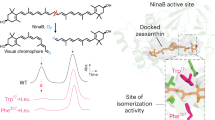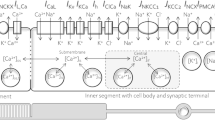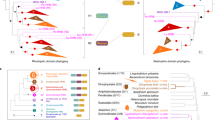Abstract
THROUGHOUT life, the outer segments of rod photoreceptors (ROS) are renewed continually1, a process that entails assembly of new disk membranes at the base of the ROS. Biosynthesis of the apoprotein of rhodopsin, the major membrane protein of the ROS disks, is known to occur in several stages in the inner segment2–5. Bok has found, however, that completion of the rhodopsin molecule by combination with its retinaldehyde prosthetic group does not take place until after the apoprotein has been transported to the ROS6, perhaps just before its insertion in to the membrane. The process continues unimpaired in darkness7,8, so that in these conditions a pool of 11-cis vitamin A should be readily available close to the site of synthesis.
This is a preview of subscription content, access via your institution
Access options
Subscribe to this journal
Receive 51 print issues and online access
$199.00 per year
only $3.90 per issue
Buy this article
- Purchase on Springer Link
- Instant access to full article PDF
Prices may be subject to local taxes which are calculated during checkout
Similar content being viewed by others
References
Young, R. W., J. Cell Biol., 33, 61–72 (1967).
Bok, D., Basinger, S. F., and Hall, M. O., Expl Eye Res., 18, 225–240 (1974).
O'Brien, P. J., and Muellenberg, C. G., Expl Eye Res., 18, 241–252 (1974).
Hall, M. O., Bok, D., and Bacharach, A. D. E., J. molec. Biol., 45, 397–406 (1969).
Papermaster, D. S., Converse, C. A., and Siu, J., Biochemistry, 14, 1343–1352 (1975).
Bok, D., Abstr. Ass. Res. Vision Ophthal. Sarasota, USA, No. 5, 32 (1975).
Bridges, C. D. B., and Yoshikami, S., Nature, 221, 275–276 (1969).
Hall, M. O., and Bok, D., Expl Eye Res., 18, 105–117 (1974).
Papermaster, D. S., and Dreyer, W. J., Biochemistry, 13, 2438–2444 (1974).
Bridges, C. D. B., Vision Res., 15, 1311–1323 (1975).
Hubbard, R., Brown, P. K., and Bownds, D., in Methods in Enzymology, 18, (edit. by McCormick, D. B., and Wright, L. D.), 615–653 (Academic, New York, 1971).
Wald, G., J. gen. Physiol, 19, 351–371 (1935).
Hubbard, R., and Dowling, J. E., Nature, 193, 341–343 (1962).
Bridges, C. D. B., Expl Eye Res. (in the press).
Andrews, J. S., and Futterman, S., J. biol. Chem., 239, 4073–4076 (1964).
Futterman, S., and Andrews, J. S., J. biol. Chem., 239, 81–84 (1964).
Author information
Authors and Affiliations
Rights and permissions
About this article
Cite this article
BRIDGES, C. 11-cis vitamin A in dark-adapted rod outer segments is a probable source of prosthetic groups for rhodopsin biosynthesis. Nature 259, 247–248 (1976). https://doi.org/10.1038/259247a0
Received:
Accepted:
Issue Date:
DOI: https://doi.org/10.1038/259247a0
This article is cited by
-
Interphotoreceptor retinoid-binding protein (IRBP)
Molecular Neurobiology (1993)
Comments
By submitting a comment you agree to abide by our Terms and Community Guidelines. If you find something abusive or that does not comply with our terms or guidelines please flag it as inappropriate.



